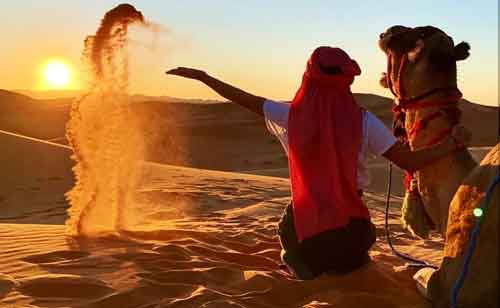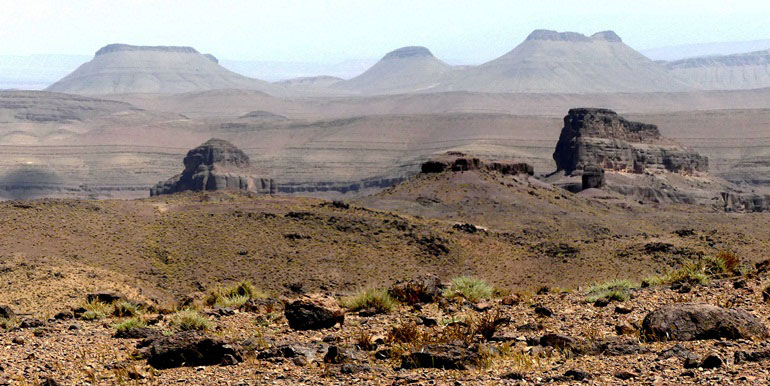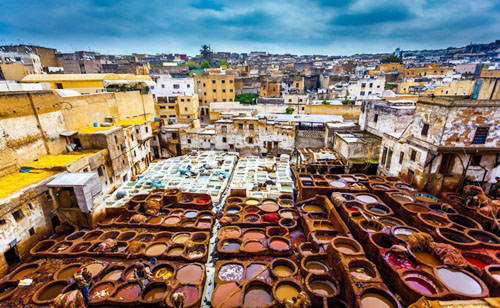
This area, containing all the highest peaks, is by far the most popular region in the Atlas Mountain for walkers. The trek up to Mountain Toubkal and the Neltner hut is undertaken by several thousand visitors each year, of all nationalities. Travel beyond the narrow confines of the Mizane valley, however, and you are unlikely to meet more one or two other trekkers. Roughly speaking, the Toubkal area is bounded by the Tizi-N’test to the west, and the Tizi N’tichka to the east. Most of the interest is concentrated in or around the central line of peaks from ouanoukrim north-east to annrhemer and angour.
The Toubkal region started to become well known to trekkers back in the 1970s. The landscape are spectacular and for walkers there are plenty of bivouac and accommodation opportunities. For the less energetic, many interesting part of the region can be visited as part of an organized 4WD excursion from Marrakech, popular are trips up onto the plateau du Kik, Imlil Valleyand in the Ourika valley. The problem is that certain treks, including Toubkal ascent are almost too popular in summer season. Nevertheless, there are plenty of alternative routes.
The mgoun Massif is in fact within relatively easy reach of Marrakech and offers some of the most superlative walking anywhere in Morocco, as well as fabulous local architecture. The mgoun Massif, unlike the Toubkal region, consists of the typical sedimentary rocks of the High Atlas with their characteristic escarpment, long crested ridges and deep gorges, cut by the rivers through the softer rocks as the young fold mountains have risen. The summit of the Mgoun Massif, variously called Ighil Mgoun or amsod (4068m) is the highest point in the Atlas outside the Toubkal Area.

Marrakech is one of the four imperial cities and a former capital of the country. At least a thousand years old it first became a town of importance during the almoravid dynasty in the eleventh century. It was during this period that the first Koutoubia mosque was built. The minaret, incidentally, still dominates the skyline of Marrakech and makes a useful central reference point. Marrakech is invariably the starting point for trips Toubkal region, clearly visible from the city during the winter months. It also makes the most sensible starting point for visits to the Mgoun area and Jebel Saghro.
Marrakech is Morocco’s main point of entry for tourism, many of whom never venture far beyond its red walls, despite the enticing and dramatic backdrop of the High Atlas Mountains, snow-capped until April or May and a venue for numerous excursions. The city has a memorable beauty, with its Palm-lined streets and red earth walls, surrounding a huge medina of flat-roofed houses. Above all, Marrakech is worth visiting to experience the vibrant mass of food stalls, musicians and snake charmers in the seething Jemaa el Fna, and for its souks – a labyrinthine network of markets, where people come to buy and sell from all over the surrounding plains, the High Atlas and the Sahara
The 4167m ( 13,670ft) high summit of Jebel Toubkal dominates the Atlas for tens og kilometers around and is at the centre of the Jebel Toubkal National Park, which covers some 36,000ha of forest and mountainside. The mountain and the surrounding park offer some treks to the summit of Toubkal taking two to six days from Imlil or Marrakech. Toublal is clearly visible from Marrakech and flanked bt almost equally dramatic summits. Even in high summer, these mountain slopes and valley can offer some respite from the heat of plains The Berber Villages of the Atlas are characteristically clutters of box-like, flat-roofed, mud-brick houses, sur-rounded by green cultivated terraces that stand out vividly against bare hillsides. The highest villages are at some 2000m (6500ft) above sea level, and spring villages drive their flocks higher into the mountains to take advantage of seasonal pastures.

One of the finest Kasbahs in Morocco, Ait ben Haddou is situated about 30Km northwest of Ouarzazate, on the Marrakech highway. A dramatically located complex of ornamented red stone and mud-brick walls with decorated towers, it stands among green terraces of barley, almond and palm trees, with the high Atlas peaks as backdrop. To the east of Ouarzazate, the highway runs through hill country through a bleak but spectacular landscape of shattered, multicolored rock, and then descends to the small town of Agdz, the gateway to the draa valley – a huge, linear oasis formed by the oued draa at it flows through arid, rocky landscape towards the Sahara .

The Moroccan Sahara is one of the world’s most iconic desert landscapes. From the towering dunes of Erg Chebbi to the remote silence of Erg Chigaga, visitors can experience camel trekking, magical sunsets, star-filled skies, and traditional Berber music around the campfire. Overnight stays in desert camps offer an authentic immersion into nomadic culture.
Adventure seekers will enjoy 4x4 desert safaris, sandboarding, and exploring the ancient caravan routes that once connected Morocco with sub-Saharan Africa. The Sahara region remains a must-visit destination for travelers seeking peace, beauty, and unforgettable moments.

Known for its blue-washed streets and peaceful vibes, Chefchaouen is one of Morocco’s most picturesque destinations. Nestled in the Rif Mountains, the city offers a blend of charming alleyways, artisanal handicrafts, and breathtaking viewpoints over the surrounding hills.
Chefchaouen is ideal for photography lovers and travelers seeking a calm escape from bustling cities. Its unique blue tones, local markets, and traditional guesthouses make it a highlight of northern Morocco.

The Saghro Mountains form a dramatic volcanic range located between the High Atlas and the Sahara. Known for their rugged beauty, basalt formations, and isolated Berber villages, this region is perfect for winter trekking and remote adventure.
With mild temperatures and minimal tourist traffic, Jebel Saghro offers a peaceful alternative to the busy Toubkal trails. The area is home to rock spires, deep canyons, and fascinating nomadic communities.

Fes boasts the oldest medieval medina in the Arab world, home to artisan quarters, ancient tanneries, and the historic Al-Qarawiyyin University. Walking through its maze of narrow alleys feels like stepping back in time.
Renowned for its scholarly heritage, traditional crafts, and vibrant souks, Fes remains one of Morocco’s most culturally rich cities. It is a must-visit for travelers seeking authenticity and history.

Ouzoud Waterfalls, located north-east of Marrakech, is the highest and most spectacular waterfall system in Morocco. Surrounded by lush green valleys and traditional olive groves, it offers a stunning escape from the city.
Visitors can enjoy scenic hikes, boat rides, and close encounters with friendly Barbary macaques. The waterfalls are one of the most photographed natural sites in the country and a popular day trip destination.
Welcome to our virtual haven of wanderlust and exploration! In the heart of North Africa lies a hidden gem waiting to be discovered — the majestic mountains of Morocco. Join us on an extraordinary journey through terracotta-hued landscapes, ancient Berber villages, and the untamed beauty of the High Atlas.
Embark on a Path Less Traveled: Venture beyond the ordinary and immerse yourself in the soul-stirring allure of Moroccan trekking. Our blog is your passport to a world where every trail tells a story, and every summit unveils a panoramic tapestry of nature's wonders. Discover Hidden Gems: From the snow-capped peaks of Toubkal to the winding trails of Jebel Sarhro, our blog unfolds the secrets of Morocco's diverse mountain ranges. Get ready for a visual feast as we take you through valleys adorned with wildflowers, under the shade of ancient walnut trees, and into the heart of nomadic communities. Cultural Encounters: It's not just about the landscapes; it's about the people who call these mountains home. Experience the warmth of Berber hospitality, savor traditional cuisine, and partake in age-old customs that make every step of the journey a cultural immersion. Practical Tips and Insights: Whether you're a seasoned trekker or a first-time adventurer, our blog is your resource for practical tips, expert insights, and firsthand accounts of the trails less traveled. From packing essentials to cultural etiquette, we've got you covered. Get Ready to Trek with Us: Are you ready to lace up your boots and venture into the extraordinary? Our blog is your gateway to the wonders of Moroccan trekking. Let the stories unfold, the images inspire, and the adventures beckon. Your journey begins here! Title: "Embark on an Epic Moroccan Odyssey: Trekking, Tales, and Tranquility" Welcome to the enchanting world of Moroccan trekking, where each step is a dance between rugged landscapes and timeless traditions. Our journey unfolds beneath the azure skies of North Africa, amidst the majestic mountains that guard Morocco's secrets. Discover the Majesty of Morocco's Mountains: In the heart of this captivating land, the High Atlas Mountains rise, adorned with snow-capped peaks that whisper tales of ancient civilizations and breathtaking vistas. Join us as we traverse the iconic Toubkal Circuit, a trail that weaves through valleys dotted with terracotta-hued villages, providing a panoramic view of Morocco's diverse beauty. Trekking Through Time: Morocco is a living canvas painted with the footprints of nomads, the echoes of Berber songs, and the whispers of mountain breezes. Our treks offer a portal into this rich history, as we explore hidden gems like the M'Goun Massif, where each step resonates with the stories of a bygone era. Nomadic Encounters and Cultural Marvels: Beyond the landscapes lie the beating heart of Morocco — its people. Engage in the warmth of Berber hospitality, share tales with local shepherds, and savor the flavors of traditional tagines. Our journeys are not just about reaching summits; they are about immersing yourself in the vibrant tapestry of Moroccan culture. Tales from the Trail: Join us as we share firsthand accounts and vivid narratives from our treks. From conquering the challenging trails of Jebel Sarhro to basking in the tranquility of the Ait Bougmez Valley, our blog is a treasure trove of experiences, offering practical tips, stunning visuals, and the camaraderie of fellow adventure seekers. Your Gateway to Morocco's Magic: Whether you are a seasoned trekker seeking new heights or a novice explorer craving the allure of the unknown, our blog is your compass. Dive into the world of Moroccan trekking with us — where the mountains are your companions, the trails your storytellers, and the adventure your muse. Plan Your Moroccan Expedition: Ready to weave your own tale in the mountains of Morocco? Explore our curated treks, gather insider tips, and let the spirit of adventure guide you. Your journey into the heart of Morocco's grandeur begins now. Embark on an epic odyssey with us — where every trail is a chapter, every summit a triumph, and Morocco's mountains, your timeless muse.2. The Kingdom of Morocco is the official name of Morocco.
3. There are approximately 36 million people living in Morocco.
4. The capital city of Morocco is Rabat.
5. The largest city in Morocco is Casablanca.
6. The official currency of Morocco is the Dirham.
7. The people of this area are called Berbers or Amazigh.
8. Moroccans speak a dialect of Arabic known as Darija.
9. Toubkal is the tallest mountain of Morocco and the highest peak in North Africa.
10. The Karawan mosque in Fez is the oldest university in the world built by Fatima al-Fihri.
11. The most well-known Moroccan food is couscous, a dish typically eaten on the Islamic holy day.
12. The most popular sport in Morocco is Football.
13. The official languages of Morocco are Berber and Arabic.
14. Morocco celebrates their national holiday of Throne Day on July 30 each year.15. Green tea with mint and sweetened with sugar their popular beverage.
16. Morocco has the fifth largest economy throughout Africa.
17. The major exports include citrus fruits such as tangerines, clementines, and mandarins.
18. Tarfaya Wind Farm in Morocco is Africa’s largest capacity wind farms.
19. Morocco is the largest energy importer in the MENA region.
20. Tourism is one of the country’s most important economic industries.
21. The second largest film set in the world located in Morocco.
22. Marrakech is a popular tourist attraction in Morroco.
23. Agadir is one of the major urban centers of Morocco and is located on the Atlantic Ocean.
24. Agadir was mostly destroyed by an earthquake in 1960.
25. Souk El Had is an Agadir’s largest regional market with around 6,000 small shops.
26. The national animal of Morocco are Barbary Lions.
27. Morocco exports more than 90,000 tons of dates each year all around the World.
28. A Moroccan widow wears white for 40 days after her husband’s death to show she is in mourning.
29. Morocco shares its border with Algeria and Western Sahara.
30. Morocco is the largest producer and exporter of sardines in the world.
31. The Hassan II Mosque in Casablanca is the world’s seventh largest mosque.
32. The Moroccan national costume is called Djellaba.
33. Tangier is the oldest city in Morocco
34. Morocco’s highest point is Jebel Toubkal at 13,665 feet.
35. The lowest point of Morocco is Sebkha Tah.
.• 2.) Learn to Cook, Moroccan Style
• 3.) Wander through Aït Benhaddou.
• 4.) See the city of Marrakech.
• 5.) Stroll Through the Blue Streets of Chefchaouen
• 6.) Walk the desert at Merzouga AND Overnight in the Sahara Desert
• 7.) Explore the capital, Rabat.
• 8.) Spend a few days in Tangier.
• 9.) Steam in a Traditonal Hammam
• 10.) Go Surfing at the Coast
• 11.) Perfect Your Haggling Skills in the Souks
• 12.) Trek the High Atlas Mountains
• 13.) Book a Stay in a Traditional Riad
• 14.) Hit the Slopes at Oukaïmeden
• 15.) Attend a Cultural Festival
• 2.) Blue city of Chefchaouen
• 3.) Merzouga Desert – Erg Chebbi Dunes
• 4.) Ait ben haddou
• 5.) Tangier
• 6.) Fes & Meknes
• 7.) Essaouira
• 8.) High Atlas Mountains
• 9.) Morocco Gorges
• 10.) Morocco Waterfalls
• 11.) Mountain Toubkal
• 12.) Assilah
• 13.) Visit of a berber Home Family